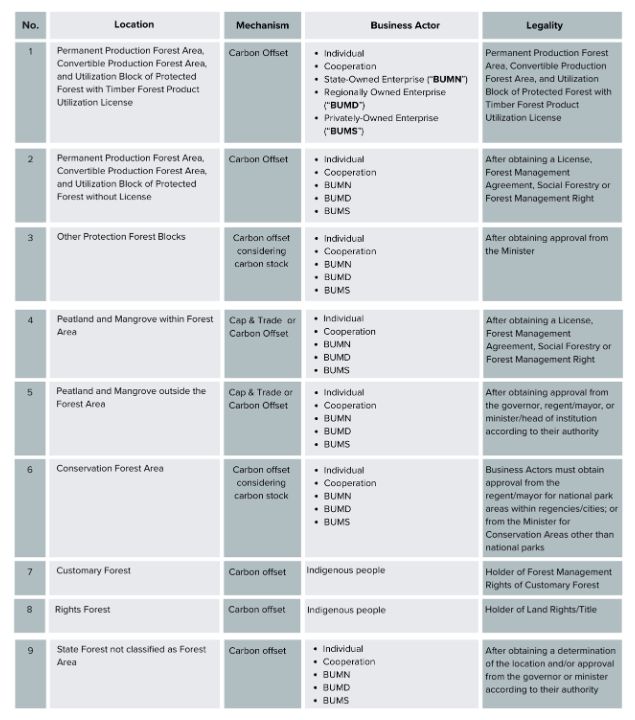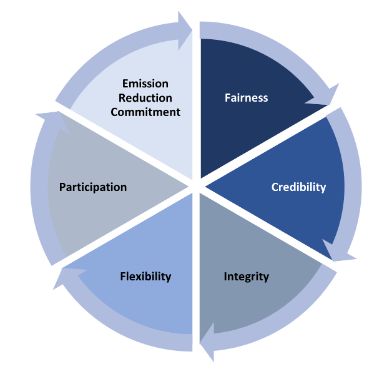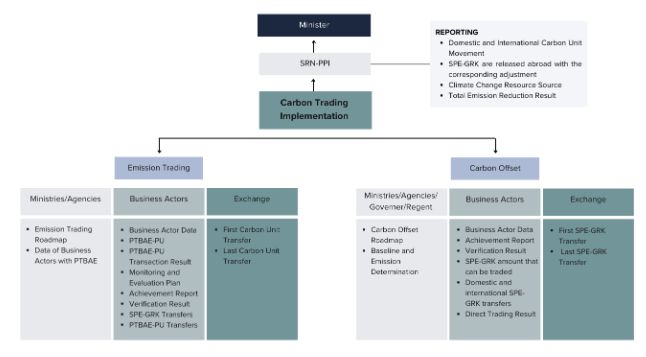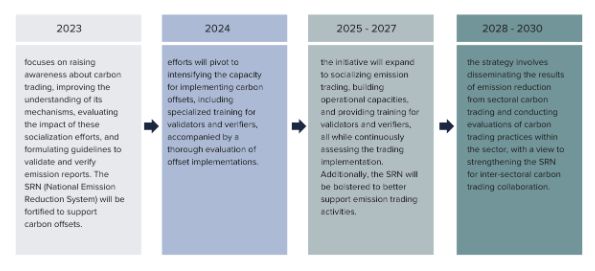In a landmark move two months ahead of COP 28, the Indonesian Ministry of Environment and Forestry (“MOEF”) cemented a pivotal Ministerial Decree No. SK.1027/MENLHK/PHL.KUM.1/9/2023 concerning Forestry Sector Carbon Trade Roadmap, shaping the future of carbon trading within the forestry sector. This decree ushers in the ‘Forestry Roadmap,’ a strategic document designed to steer carbon trading activities towards a regulated and sustainable framework (“Forestry Roadmap”).
This ARMA Update delves into the essence of this roadmap, highlighting its anticipated impact on environmental stewardship, adherence to legal standards, and the broader forestry industry. It provides an essential primer for all stakeholders, including industry participants, legal entities, and policy architects, empowering them to navigate the intricacies of this evolving regulatory landscape.
Forestry Roadmap
The Forestry Roadmap provides a regulatory blueprint for carbon trading within Indonesia’s forestry sector as presented in the table below, outlining the specific locations eligible for carbon trade, from production to protected areas, including peatlands and mangroves. The document provides a comprehensive overview of the carbon offset mechanisms and identifies potential participants, ranging from individuals to various enterprises. Importantly, the table delineates the legal prerequisites for involvement, emphasizing the need to acquire necessary permits and respect forest management rights. This ensures that all carbon trading activities adhere to national regulations and support sustainable forestry management practices. The framework plays a crucial role in helping stakeholders effectively navigate the legal landscape of Indonesia’s carbon market.
Following the overview of the legal framework for carbon trading in Indonesia’s forestry sector, the Forestry Roadmap restated the criteria and requirements for business actors interested in participating in this market, as we have previously elaborated in our previous ARMA Update.

Source: Table 1 of Forestry Roadmap: Locations, mechanisms, business actors, and legalities.
Climate Change Mitigation Actions in the Forestry Sector
The climate change mitigation actions outlined in the Forestry Roadmap remain aligned with those specified in MOEF Regulation No. 7 of 2023 concerning the Guideline of Carbon Trading in the Forestry Sector (“MOEF 7/23“). These actions focus on reducing greenhouse gas (“GHG“) emissions and enhancing carbon storage and/or sequestration, continuing the established efforts to combat climate change through strategic forestry management and trading practices.
However, the activities are now categorized into the following main activities, which are:
1. Reduction of deforestation
Emission reduction from the conversion of natural forests (primary and secondary) to non-forest areas on mineral soil, peat, and mangrove.
Mitigation Action Scope
- Deforestation rate reduction on mineral lands
- Deforestation rate reduction of peatlands and mangroves
- Biodiversity conservation
- Social forestry (in high-risk Conservation Forest Management Units/Production Forest Management Units)
- Assistance for customary forests
- Supervision and law enforcement to support forest area protection and security
- Other activities in accordance with the development of science and technology
2. Reduction of forest degradation
Emission reduction from the transformation of primary natural forests into secondary natural forests on mineral soil, peat, and mangrove.
Mitigation Action Scope
- Deforestation rate reduction on mineral lands
- Deforestation rate reduction of peatlands and mangroves
- Biodiversity conservation
- Assistance for customary forests
- Supervision and law enforcement to support forest area protection and security
- Other activities in accordance with the development of science and technology
3. Development of forest plantations
CO2 absorption through planting for the supply of industrial wood needs.
Mitigation Action Scope
- Plantation forest development
- Social forestry
- Other activities in accordance with the development of science and technology
4. Sustainable forest management
Emission reduction through enrichment activities (Enhanced Natural Regeneration)/Intensive Silviculture Techniques (SILIN) and Reduced Impact Logging for climate change (RIL-C).
Mitigation Action Scope
- Sustainable forest management
- Social forestry
- Other activities in accordance with the development of science and technology
5. Enhancement of carbon stocks
Increase in CO2 absorption through rehabilitation activities on unproductive land and cultivation with rotational and non-rotational crops.
Mitigation Action Scope
- Rehabilitation with rotation
- Non-rotational rehabilitation
- Peat restoration
- Mangrove rehabilitation
- Afforestation in ex-mining areas
- Construction of permanent nurseries
- Plant rehabilitation under 5 (five) years
- Eco riparian
- Social forestry
- Introduction of ecosystem replication
- Development of green open spaces
- Other activities in accordance with the development of science and technology
6. Improvement of peatland water management
GHG emission reduction through improved management of peatland water regulation.
Mitigation Action Scope
- Improvement of peat water system
- Other activities in accordance with the development of science and technology
7. Advancements in science and technology that encourage innovation and more effective climate change mitigation actions.
The use of technology that can increase the efficiency of forest management, accelerate emission reduction, and enhance the performance of carbon absorption and storage from the forestry sector.
Mitigation Action Scope
- Other activities in accordance with the development of science and technology
Principles of Carbon Trading in the Forestry Sector
According to the Forestry Roadmap, carbon trading in the forestry sector shall meet the following principles, which are designed to align with the environmental sustainability goals:

a. Emission Reduction Commitment: Supports achieving the Nationally Determined Contributions (“NDCs“) with realistic targets and cohesive policies, considering a baseline for emissions to balance environmental and economic impacts.
b. Fairness: Reflects the “polluter pays principle,” holding those responsible for pollution accountable for costs to prevent environmental damage.
c. Credibility: Ensures each carbon unit accurately represents an emission reduction, supported by a robust Measurement, Reporting, and Verification (“MRV“) system.
d. Integrity: Focuses on transparency regarding market participation, emission data, and the ownership of carbon units, with all information recorded in a registry system.
e. Flexibility: Aims to address potential issues while maintaining carbon prices and transaction costs, allowing for project validation and verification by independent parties.
f. Participation: Encourages active community involvement in environmental protection and management decisions.
Strategy for International Carbon Trading
In the context of global climate initiatives, international carbon trading in the forestry sector is executed with a comprehensive strategy, involving a coalition of government ministers, provincial governors, regents, mayors, and business entities. These actors collaborate to implement climate change mitigation actions, underscoring the sector’s strategic role in supporting national environmental commitments.
The principles governing investment cooperation in international carbon trade necessitate the development of high-quality carbon units that adhere to stringent transparency and consistency standards, collectively known as TACCC — transparency, accuracy, consistency, continuity, and comparability. This framework is essential for preserving the environmental integrity of the carbon market and ensuring that emission reductions contribute positively to the Nationally Determined Contributions (NDCs) without causing unintended increases elsewhere. This is a central concept in avoiding double counting and ensuring the credibility of carbon crediting.
Moreover, the principles mandate the implementation of a robust MRV system, which is essential for ensuring that each emission reduction is unique and not subject to multiple claims. Safeguards are also emphasized to mitigate risks associated with non-permanence and potential reversals of emission reductions.
The overarching goal of international carbon trading is to align with and support the achievement of NDC targets by easing investment, offering flexibility in the carbon trading implementation, and preventing any negative socio-economic impacts. The approach is to use the best methodologies, establish conservative baselines, and apply safeguards to ensure the carbon trading efforts contribute to sustainable forest management and the broader objectives of global climate change mitigation.
The five types of collaboration in international carbon trade are outlined as follows:
- Cooperation between Related Ministers and International Partners:
This entails collaboration with international partners authorized and with corresponding adjustments.
- Cooperation between Regional Governments and International Partners:
This is conducted in alignment with their respective authority with proper authorization and corresponding adjustments.
- Cooperation between Business Actors or Communities and International Partners:
This can be conducted in three mechanisms:
a. With authorization and corresponding adjustments.
b. With authorization and without corresponding adjustments or with zero percent corresponding adjustments.
c. Without authorization and corresponding adjustments.
- Cooperation between Related Ministers, Regional Governments, Business Actors, and Communities with International Partners:
Implemented through mechanisms such as grant assistance or non-market mechanisms, in accordance with applicable legal regulations, without authorization and without corresponding adjustments.
- Cooperation between National Business Actors and International Business Actors for Labelling:
For market demands and environmentally friendly financing, conducted without authorization and corresponding adjustments, in accordance with applicable legal regulations.
Strategy for National Emission Trading
The strategies and approaches to achieving the objectives of emission trading (cap & trade) in the Forestry Sector include, among others:
- Use of offset units as a substitute for the Business Actor’s Emission Upper Limit Technical Approval (Persetujuan Teknis Batas Atas Emisi Pelaku Usaha or “PTBAE-PU”): Participants in cap & trade can use the GHG Emission Reduction Certificate (Sertifikat Pengurangan Emisi Gas Rumah Kaca or “SPE-GRK“) or an emission reduction certificate declared equivalent to SPE-GRK in accordance with applicable legal regulations to replace part of their obligation to achieve PTBAE-PU.
- Auction: If the amount of PTBAE-PU circulating in the market is considered too low, the Government can auction the remaining PTBAE that has not yet been allocated to businesses. The auction will be conducted through an exchange and/or designated third parties. Revenue from the auction will be used to encourage mitigation in the Forestry Sector.
- Reduction in the number of PTBAE-PU: To encourage increased efficiency and implementation of climate change mitigation in the forestry sector, the Government can reduce the number of PTBAE-PU allocations by reducing the PTBAE-PU intensity value for some or all categories of participants in emission trading in the Forestry Sector.
Targets for Carbon Offset Activities in the Forestry Sector
Carbon Offset in the forestry sector is carried out for businesses and/or activities that:
- do not have a PTBAE-PU;
- have an emission surplus, where the achievement of GHG emission reduction from climate change mitigation actions is below the set target and baseline GHG emissions; or
- have an emission deficit, where the achievement of GHG emission reduction from climate change mitigation actions is above the set target and the established baseline GHG emissions.
Establishment of GHG Emission Baseline and Emission Reduction Targets for Business Actors
The strategy for carbon trading within the domestic forestry sector employs a systematic approach to establish baselines and targets for emission reductions. Companies can propose their own baselines and targets, which are then formally established. These benchmarks consider historical conditions and adhere to existing regulations.
Measurements of baseline and actual emissions must adhere to approved methodologies, such as those outlined by the IPCC, or national standards set by the Indonesian government. This ensures accuracy and conservatism in the calculations. Alternatively, expert panel assessment mechanisms approved by the government can be employed to propose alternative methods for determining baselines and actual emissions, with mutual recognition.
The mitigation action plan, known as the Climate Change Mitigation Action Plan Document (Dokumen Rancangan Aksi Mitigasi Perubahan Iklim or “DRAM“) or similar to a project design document (PDD), should be based on a company’s existing forest management plans. A buffer of emission reductions is set aside for GHG emission offsets to address any potential shortfall. This buffer is set at various levels for domestic and international trading, and for trading outside the NDC scope.
Baseline emissions are the GHG emission levels that form the basis for evaluating performance in reducing emissions within the offset mechanisms. The calculation of historical emissions for the baseline is done using time-series data over a specified reference period, with annual emissions during this period averaged to obtain a consistent baseline in CO2e per year.
Carbon Offset Period and Compliance Period for Emission Reduction Performance Measurement
The carbon offset period and the compliance period for measuring the performance of emission reduction in the forestry sector up to the year 2030 will be organized in agreed-upon intervals, for example, Period-1: 2023-2026 and Period-2: 2027-2030.
Harmonization of the Carbon Pricing Implementation Mechanisms
As is commonly understood, the execution of carbon pricing takes place through various mechanisms, including carbon trading, performance-based payments, carbon levies, and/or other methods in line with advancements in science and technology. To prevent the occurrence of double counting and double payment, coordination between these mechanisms is achieved through the establishment of the National Registration System, incorporating various mechanisms, such as:
a. Planning of emission reduction mitigation actions and the DRAM;
b. The mandatory registration by business actors in the Indonesian National Registry System for Climate Change Control (Sistem Registri Nasional Pengendalian Perubahan Iklim or “SRN PPI“);
c. Validation of MRV reporting; and
d. Verification of reporting results.
Illustration of Carbon Unit Transaction Recording and Reporting in the Forestry Sector

Recording and Reporting of Emission Trading
GHG Emission Reports for the forestry sector that follow the emission trading must be validated and verified by independent Validators and Verifiers in accordance with applicable legal provisions. In the case where the number of Validator and Verifier institutions is not yet sufficient in Phase-1 of the emission trading implementation, validation and verification can be conducted by experts who meet the following qualifications:
- Have an educational background in engineering or science and have work experience related to the operation of the forestry sector for at least 3 (three) years.
- Possess a competency certificate according to Indonesian national work competency standards and/or National Standard training certificate of Indonesia, or an equivalent international standard, in the field of GHG statement validation and verification.
- Registered as an expert in Validation and Verification at SRN PPI.
The Carbon Trading Action Plan for the Forestry Sector from 2023-2030
Designed to enhance climate change mitigation efforts, the execution of the carbon trading action plan for the forestry sector involves a series of activities and actions aimed at improving the readiness of stakeholders in terms of policy, technical, and institutional aspects. The plan, as outlined below, encompasses socialization, capacity building, evaluation, and facilitation. These coordinated efforts are essential for the successful implementation of carbon trading within the forestry sector, ensuring that all parties are prepared and the infrastructure for carbon trading is robust and effective.

Source: Table 10 of Forestry Roadmap: Action Plan in the Implementation of the Emission Trading Roadmap for the Forestry Sector
This roadmap outlines the strategic initiatives planned over several years to enhance the effectiveness of emission trading within the forestry sector, detailing activities that range from socialization and capacity building to the evaluation and facilitation of various processes related to carbon trading.



